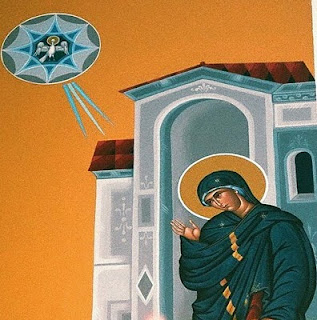
Today, September 8 (Revised Julian Calendar), the Holy Orthodox Church celebrates the birth of Mary, the Theotokos.
Friends of mine have been trying to have children for several years now. Each time the pregnancy could not be carried to term. Such times were very hard on them. Thanks be to God, through in vitro fertilization, my friend is pregnant and is now past 15 weeks which is the cut-off point for predicting success. My friends are overjoyed beyond belief and I rejoice with them. I can only imagine, had this pregnancy not happened, how my friends would have looked at themselves if they had gone through the rest of their lives childless. Or, to use a much more sinister and harsh term, to go through the rest of their lives barren.
I'm sure that such thoughts were equally on the minds of Sts. Joachim and Anne. Though today it is more often the case, even fashionable, for married couples to not have children. Sometimes it is out of necessity and sometimes it is out of a desire to not lose the freedom that invariably comes when children come into the picture. But, in classical antiquity, to be childless or, again that bad word, barren was considered to be a great stain. Today, we might laugh at the story of Niobe who bragged because she had more kids than the goddess Leto. Leto then ordered her twins, Apollo and Artemis to take out Niobe's children because of Niobe's haughty boast. But to the Greeks and other civilizations of the Mediterranean world, having children was not considered only a blessing but an obligation. The more, the better. However, Sts. Joachim and Anne had none.
They may well had never thought about it until one year when St. Joachim, already very aged, went to the temple to offer his sacrifice. St. Joachim was turned away by the high priest because Joachim's lack of children made him unworthy. Distraught, Joachim retreated to the desert. Anne heard of Joachim's withdrawal into the wilderness and she began a fast and fervent prayer. The Archangel, Gabriel, appeared to both of them announcing that even in their old age, barren as they appeared to be, they would become parents. And, today, on September 8, we celebrate the result of that announcement--the birth of Mary.
This birth though was certainly unusual because of the age of the parents, but, all and all, it was a normal birth. And Mary entered this world just as the rest of us, inheriting the corruption which we all have because of the ancestral sin. She was not immaculately conceived, as the Roman Catholics say, but she was marked and chosen of God. Today is the beginning of our salvation.
Though the story of Sts. Anne and Joachim is not found in Scripture but in the
Protoevangelion of St. James and the
Gospel of the Birth of Mary, neither of which are considered canonical Scripture, subscribing to the literal truth should not be at the expense of the theological truth. Even if the Gospels only mentioned Sts. Anne and Joachim and their offspring, the Theotokos, I think the Church would still rightly honor all of them on this day and tomorrow (September 9 is the Feast of the Synaxis of Sts. Joachim and Anne). What is this theological truth?
The epistle for this feast is taken from St. Paul's Epistle to the Philippians (2:5-11) where St. Paul reminds us that "...[Christ] made Himself of no reputation, and took upon Him the form of a servant, and was made in the likeness of men: and being found in fashion as a man, He humbled Himself, and became obedient unto death, even the death of the cross." Christ's perfection is revealed and demonstrated in weakness. The barrenness of Sts. Joachim and Anne is made perfect in giving birth to the Theotokos who carried the One who cannot be contained!
Such knowledge should be a source of great joy for us! Barren as we are because of our sins, because of Christ's rising from the tree of barrenness, can we not also now bear fruit, living the life that Christ has set before us? This feast, though dedicated to Mary, and like every other Marian feast, points us directly to Christ just as she points to Him in our iconography. Mary's Nativity sets the stage for the Incarnation. If her birth was not an ordinary birth, then could Christ really assume all that we really are so that our nature could be wholly healed? No.
The Church places this feast at the start of the New Year. Our Church year ends with the Dormition of the Theotokos. At Vespers at Psalm 140 and the Aposticha and at Orthros at the Praises, there is always a hymn dedicated to Mary, called the Theotokion. Mary is the seal which brings God and Man together and such is the theme of such Theotokia. Without our Lady's birth, there could be no Incarnation and without our Lord's incarnation there could be no Crucifixion and Resurrection and without those, there would be no reason to celebrate Mary's Dormition. All these feasts are tied together.
Mary's birth was a time of joy for St. Joachim and St. Anne, but it should also be a happy and joyous time for all creation. "Thy Nativity, O Theotokos, hath brought joy to the whole universe" says the Apolytikion of the Feast. This is the foreshadowing of the eventual triumph over death and barrenness that our Lord will accomplish at His Pascha. Let us rejoice!







